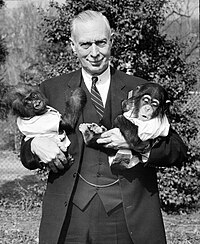Leonard Carmichael
| Leonard Carmichael | |
|---|---|
 |
|
| 7th Secretary of the Smithsonian Institution | |
|
In office 1953–1964 |
|
| Preceded by | Alexander Wetmore |
| Succeeded by | Sidney Dillon Ripley |
| Personal details | |
| Born | November 9, 1898 Philadelphia, Pennsylvania |
| Died | September 16, 1973 (aged 74) |
| Nationality | American |
| Education |
Tufts University (BS) Harvard University (PhD) |
| Known for | Psychology |
Leonard Carmichael (November 9, 1898 – September 16, 1973) was an American educator and psychologist. In addition, he became the seventh secretary of the Smithsonian Institution in 1953.
Carmichael, the son of a physician and a teacher, was born in 1898, in Germantown, Pennsylvania. He received his BS degree from Tufts University in 1921, and his PhD from Harvard University in 1924. He was a brother in the Theta Delta Chi fraternity during his time at Tufts. He became an instructor at Princeton University's Department of Psychology in 1924 and was appointed to assistant professor in 1926. For fourteen years, Carmichael taught at Brown University, focusing on experimental psychology with primates. After being part of the Brown University faculty from 1927 to 1936, he left for the University of Rochester. He was appointed president of Tufts University in 1938, serving until his departure for the Smithsonian in 1953.
Carmichael served as the secretary of the Smithsonian Institution from 1953 to 1964. He was the first Secretary to be hired from outside the Institution, rather than promoted from within. During Carmichael’s tenure, the National Portrait Gallery was created, the Patent Office Building was acquired for the American Art and Portrait Galleries, and the Museum of History and Technology (now the National Museum of American History) was opened. New wings were added to the National Museum of Natural History, the Hope Diamond was donated by Harry Winston, and the Fénykövi elephant was unveiled in the rotunda of the Natural History Museum. The Smithsonian Astrophysical Observatory was revitalized and moved to Cambridge, Massachusetts. In 1957, when Sputnik was launched, the observatory was the only US lab capable of tracking the Soviet satellite. After the death of a visitor at the National Zoological Park, Carmichael sought additional funding for major improvements to meet safety regulations. The Friends of the National Zoo was created and a Master Plan for zoo improvement was formulated and initiated.
...
Wikipedia
